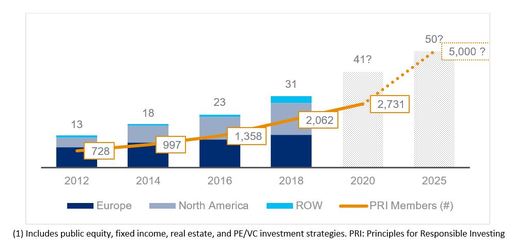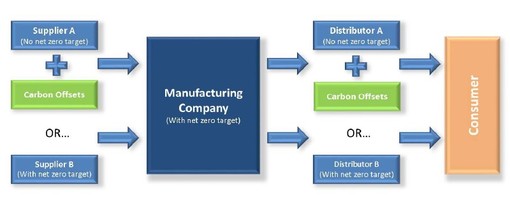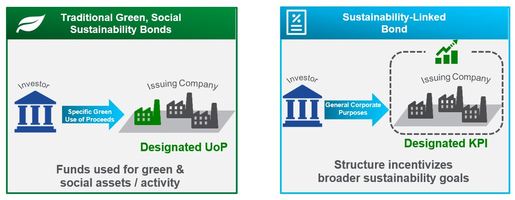
Louise O'Mara
Citi too is committed to accelerating the transition to a low-carbon economy through our 5 year, $250bn Environmental Finance Goal. We aim to finance and facilitate environmental projects across a variety of sustainability initiatives including renewable energy, clean technology and sustainable agriculture and land use.
Stakeholders Accelerating the Sustainability Agenda
As a sense of urgency develops among key stakeholders groups, corporate strategy will need to adapt to the rapid pace of change. Asset managers, the financial sector and governments are increasingly supportive of the sustainability transition. Funds invested in ESG assets are ballooning as asset owners and managers seek sustainable solutions. As outlined in Figure 1, sustainable assets under management have now surpassed $30trn and could grow to $50trn by 2025.
Sustainable investing styles vary, with basic exclusionary approaches still dominant, though ESG integration is now almost on a par and growing much faster. Companies are focussed on developing a robust sustainability strategy so they can access this ever growing source of capital. In September 2020, AIB tapped this market with the issuance of their inaugural €1.0bn Green Bond, for which Citi was Joint Lead Manager. The transaction attracted significant interest from high quality investors with the green format maximising the depth of demand.
Net Zero and the Supply Chain
With an increasing number of corporate, sovereign and supranationals setting targets to be ‘net zero’ by a certain date, the drive to achieve these targets with tangible strategies and business plans is growing. However, not all net zero targets are created equal, and the toughest and most comprehensive of these, the ‘Scope 3’ net zero target, requires a company to effectively achieve net zero across all elements of its supply or distribution chains. What this means in practice, is that a company with a net zero target will require its suppliers to be net zero, or it may have to purchase offsets to bridge that gap - at a cost (see graphic below).
Consequently, that supply chain contract might therefore be renegotiated to a different price to reflect that cost, or indeed the company may move to a different supplier which is net zero, thereby avoiding that incremental cost.
The reason this is so significant, is that it is one of the first real world business examples of emissions (and sustainability) actually impacting margins and pricing strategies within companies. Accordingly, what we are beginning to see (in its early stages, but with rapidly building momentum) is the creation of a net-zero club, populated by companies which are essentially seen as part of the solution.
Green and Sustainability-Linked Financing
Companies are increasingly linking sustainability Key Performance Indicators (KPIs) to financing and there are an array of green and sustainability-linked finance options available. The most common issued bonds in the sustainability bond market are Green, Social and Sustainability Bonds. However recently we’ve seen the emergence of several other variations including Transition Bonds and KPI-Linked Bonds. The simplest form is a Green Bond where the use of proceeds are directed solely towards eligible green projects. Citi led Ireland’s inaugural Green Bond in October 2018. The proceeds of the Green Bond, issued through the National Treasury Management Agency (NTMA), were allocated against eligible green projects which primarily address climate change mitigation, clean water and wastewater treatment, amongst other core environmental objectives.
Sustainability-Linked Bonds (SLBs) are, by design, linked to material sustainability objectives of the issuing company. SLBs are any bond in which the cost or structural characteristics can vary depending on whether the company achieves defined sustainability/ESG objectives. Companies are thereby committing explicitly to future sustainability outcomes and creating a financial incentive to do so.
The “Greenium”, or green premium, refers to the pricing advantage offered to companies through the use of green bonds or SLBs over conventional bonds. We have seen that Green, Social and Sustainability bonds can achieve a pricing benefit due to a higher degree of demand from investors.
Co-dependency of Finance and Sustainability
Sustainability and the worlds of business and finance have often existed in parallel but have struggled to translate sustainability matters into financial ones. We have seen sustainability and finance as separate entities, with sustainability seen as being a cost which is ‘indulged’ at the expense of margin. What is so exciting about the ‘net-zero club’ and the ‘greenium’ is that they represent tangible examples of a sustainability-related issue directly impacting pricing and margins – sustainability meets finance in its most fundamental sense. As consumer sentiment and societal attitudes continue to shift, we should expect this to become the norm rather than the exception, with finance and sustainability walking hand in hand in the same direction.



